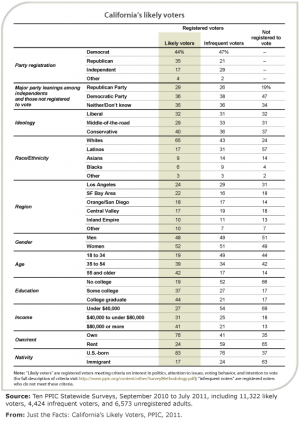In recent elections, voting ranks in California have steadily declined. In fact, the 2010 U.S. Census reported that the state had the nation’s second lowest rate of voter registration in the nation, and one of the lowest voter turnout rates.
California also has the dubious distinction of having one of the largest percentages of adults who are not eligible to vote, in large part due to the roughly 17 percent of residents who are non-citizens.
Why aren’t more people voting (and why should you care)?
California's meager voter turnout is due in part to the growing number of people who don't think they have a role in government. And this is a problem, because it’s the participation and civic engagement of everyone - majority and minority -that makes democracy work. When so many voices are not being heard, it raises the question of whether our government is actually fulfilling it’s obligation to represent everyone.
Who are California’s likely voters?
There are nearly 24 million Californians who are eligible to vote and they can generally be evenly divided into three categories:
- Habitual voters: those who always vote
- Periodic voters: those who are registered but only vote occasionally
- Unregistered: those who are eligible but not registered
Likely voters do not represent the diversity of the state's population. They are disproportionately white and tend to have incomes and levels of education that are notably higher than the state’s average. A recent Public Policy Institute of California study found that:
- Non-Hispanic whites constitute only 44 percent of California's adult population but make up 65 percent of the state's likely voters.
- Hispanics make up a third of the state's population but represent only 17 percent of likely voters.
The study also found large regional disparities, with significantly higher rates of unregistered adults located in particular communities throughout the state.
Most public discourse around California politics is directed at habitual voters; it assumes a high level of interest, awareness, and experience. But getting the remaining two-thirds to more fully participate requires a very different approach.
What are the most common factors the prevent people from voting?
It's commonly assumed that apathy is the main factor behind low voter turnout; the notion that nonvoters are lazy or don’t really care. In surveys, the majority of nonvoters commonly say they don’t participate because they don't have the time, don’t like the choices, or don’t think their vote will matter.
In our ongoing analysis of this issue, the League of Women Voters of California has consistently found that a majority of nonvoters don't have sufficient understanding about the voting process, how it works, and why their vote really does matter. New voters also often lack access to clear, non-partisan information and guidance.
In particular, we identified three main constraints among nonvoters:
- Many do not see the connection between politics and their own lives
- Many perceive the voting process as difficult and intimidating, like taking an exam
- Many do not receive direct encouragement to vote from friends and family (we found, for instance, that the most important predictor of whether young people vote is if they grew up in a household with voters)
What are some ways to increase voter turnout?
Both new and experienced voters we talked to requested more user-friendly nonpartisan information. Specifically, new voters asked for:
- Reasons why to vote, from a peer perspective
- Hands-on training on how to vote
- Basic information about what they are being asked to vote for (how to choose a political party, which types of elected officials are running, and what those positions actually do).
In general, if we are to effectively open the voting process to a greater number of the number of Californians, we have to better address and clearly articulate the fundamentals of how to do it and why it matters.
The League of Women Voters of California Education Fund operates various voter education initiatives in partnership with community organizations and educational institutions throughout California.

